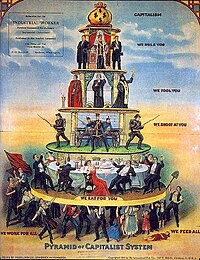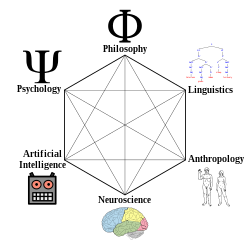The proletariat (/ˌproʊlɪˈtɛəriət/ from Latin proletarius "producing offspring") is the class of wage-earners in an economic society whose only possession of significant material value is their labour-power (how much work they can do). A member of such a class is a proletarian.
Marxist theory considers the proletariat to be oppressed by capitalism and the wage system.
This oppression gives the proletariat common economic and political
interests that transcend national boundaries. These common interests put
the proletariat in a position to unite and take power away from the
capitalist class, in order to create a communist society free from class distinctions.
Proletarii in Ancient Rome
The proletarii constituted a social class of Roman citizens owning little or no property. The origin of the name is presumably linked with the census,
which Roman authorities conducted every five years to produce a
register of citizens and their property from which their military duties
and voting privileges could be determined. For citizens with property
valued 11,000 assēs or less, which was below the lowest census for military service, their children—proles (from Latin prōlēs, "offspring")—were listed instead of their property; hence, the name proletarius, "the one who produces offspring". The only contribution of a proletarius
to the Roman society was seen in his ability to raise children, the
future Roman citizens who can colonize new territories conquered by the Roman Republic and later by the Roman Empire. The citizens who had no property of significance were called capite censi
because they were "persons registered not as to their property...but
simply as to their existence as living individuals, primarily as heads (caput) of a family."
Although included in one of the five support centuriae of the Comitia Centuriata (English: Centuriate Assembly), proletarii
were largely deprived of their voting rights due to their low social
status caused by their lack of "even the minimum property required for
the lowest class" and a class-based hierarchy of the Comitia Centuriata. The late Roman historians, such as Livy, not without some uncertainty, understood the Comitia Centuriata to be one of three forms of popular assembly of early Rome composed of centuriae,
the voting units whose members represented a class of citizens
according to the value of their property. This assembly, which usually
met on the Campus Martius to discuss public policy issues, was also used as a means of designating military duties demanded of Roman citizens. One of reconstructions of the Comitia Centuriata features 18 centuriae of cavalry, and 170 centuriae of infantry divided into five classes by wealth, plus 5 centuriae of support personnel called adsidui.
The top infantry class assembled with full arms and armor; the next two
classes brought arms and armor, but less and lesser; the fourth class
only spears; the fifth slings. In voting, the cavalry and top infantry
class were enough to decide an issue; as voting started at the top, an
issue might be decided before the lower classes voted.
After the closing of the Second Punic War (218–201 BC), a series of subsequent wars, including the Jugurthine War
and various conflicts in Macedonia and Asia, resulted in a significant
reduction in the number of Roman family farmers. The effect was
therefore that the Roman Republic experienced a shortage of people whose
property qualified them to perform the citizenry's military duty to Rome. As a result of the Marian reforms initiated in 107 BC by the Roman general Gaius Marius (157–86), which expanded the eligibility of military service to the urban poor, the proletarii became the backbone of the Roman army.
Modern era reintroduction of Proletariat and Proletarian terms
In
the era of early 19th century, many Western European liberal scholars —
who dealt with social sciences and economics — pointed out the
socio-economic similarities of the modern rapidly growing industrial
worker class and the classic ancient proletarians. One of the earliest
analogies can be found in the 1807 paper of French philosopher and
political scientist Hugues Felicité Robert de Lamennais. Later it was translated to English with the title: "Modern Slavery".
Swiss liberal economist and historian Jean Charles Léonard de Sismondi,
was the first who applied the proletariat term to the working class
created under capitalism, and whose writings were frequently cited by
Marx. Marx most likely encountered the Proletariat term while studying
the works of Sismondi.
Marxist theory
Karl Marx, who studied Roman law at the Friedrich Wilhelm University of Berlin, used the term proletariat in his socio-political theory of Marxism to describe a working class unadulterated by private property and capable of a revolutionary action to topple capitalism in order to create classless society.
In Marxist theory, the proletariat is the social class that does not have ownership of the means of production and whose only means of subsistence is to sell their labor power for a wage or salary. Proletarians are wage-workers, while some refer to those who receive salaries as the salariat. For Marx, however, wage labor may involve getting a salary rather than a wage per se. Marxism sees the proletariat and bourgeoisie
(capitalist class) as occupying conflicting positions, since workers
automatically wish their wages to be as high as possible, while owners
and their proxies wish for wages (costs) to be as low as possible.
A 1911 Industrial Worker publication advocating industrial unionism based on a critique of capitalism. The proletariat "work for all" and "feed all".
In Marxist theory, the borders between the proletariat and some layers of the petite bourgeoisie,
who rely primarily but not exclusively on self-employment at an income
no different from an ordinary wage or below it — and the lumpenproletariat,
who are not in legal employment — are not necessarily well defined.
Intermediate positions are possible, where some wage-labor for an
employer combines with self-employment. Marx makes a clear distinction
between proletariat as salaried workers, which he sees as a progressive
class, and Lumpenproletariat,
"rag-proletariat", the poorest and outcasts of the society, such as
beggars, tricksters, entertainers, buskers, criminals and prostitutes,
which he considers a retrograde class. Socialist
parties have often struggled over the question of whether they should
seek to organize and represent all the lower classes, or just the
wage-earning proletariat.
According to Marxism, capitalism is a system based on the exploitation of the proletariat by the bourgeoisie. This exploitation takes place as follows: the workers, who own no means of production
of their own, must use the means of production that are property of
others in order to produce, and consequently earn, their living. Instead
of hiring those means of production, they themselves get hired by
capitalists and work for them, producing goods or services. These goods
or services become the property of the capitalist, who sells them at the
market.
One part of the wealth produced is used to pay the workers' wages
(variable costs), another part to renew the means of production
(constant costs) while the third part, surplus value
is split between the capitalist's private takings (profit), and the
money used to pay rents, taxes, interests, etc. Surplus value is the
difference between the wealth that the proletariat produces through its
work, and the wealth it consumes to survive and to provide labor to the
capitalist companies.
A part of the surplus value is used to renew or increase the means of
production, either in quantity or quality (i.e., it is turned into capital), and is called capitalized surplus value. What remains is consumed by the capitalist class.
The commodities that proletarians produce and capitalists sell are valued for the amount of labor embodied in them. The same goes for the workers' labor power
itself: it is valued, not for the amount of wealth it produces, but for
the amount of labor necessary to produce and reproduce it. Thus the
capitalists earn wealth from the labor of their employees, not as a
function of their personal contribution to the productive process, which
may even be null, but as a function of the juridical relation of
property to the means of production. Marxists argue that new wealth is
created through labor applied to natural resources.
Marx argued that the proletariat would displace the capitalist system with the dictatorship of the proletariat, abolishing the social relationships underpinning the class system and then developing into a communist society in which "the free development of each is the condition for the free development of all".
Prole drift
Prole
drift, short for proletarian drift, is the tendency in advanced
industrialized societies for everything inexorably to become
proletarianized, or to become commonplace and commodified. This trend is
attributed to mass production, mass selling, mass communication and
mass education. Examples include best-seller lists, films and music that
must appeal to the masses, and shopping malls.

